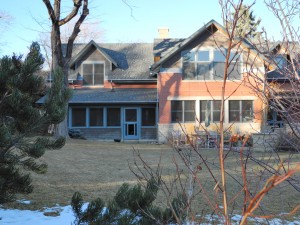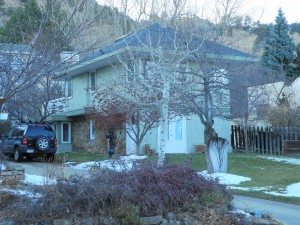
Painted by Fordham & MacLean Painters
Not too long ago it was common for painters to pack up their ladders and brushes and retreat indoors as soon as the temperature started to fall. Exterior painting was a job for the summer when the warm temperatures would allow a coat of paint to dry quickly and uniformly, and no sensible painter would so much as pop open a paint can when there was a chill in the air.
With new advances in technology, however, the exterior painting season can now stretch well into the winter under the right conditions and with the right equipment. Here are just a few tips to help you get a great paint job after the mercury falls.
Use Cold Weather Paints
Most alkyd- and water-based paints won’t cure properly unless the temperature remains above 50 degrees (depending on the manufacturer this temperature could be even higher), resulting in a coat that will be susceptible to cracking, fading and chalking much sooner than expected.
Lower temperature paints, however, are designed specifically to survive the rigors of winter weather, allowing you to paint all year round. The minimum recommended temperature of these paints will vary between brands, but in most regions it will be possible to paint on all but the coldest of days.
Keep the Substrate Dry
One of the biggest challenges with painting in cold weather isn’t temperature, but moisture. Morning dew can gather on surfaces such as windowsills or drip onto walls from gutters, and if this moisture is trapped under a coat of paint it can greatly reduce the longevity of the paint job.
When painting in low temperatures it’s advisable to wait until at least a few hours after sunrise to allow this moisture to burn away. A good paint job relies on both the ambient temperature and the substrate temperature remaining above the minimum rating for the paint, so starting too early could cause problems with curing.
Allow for Curing Time
Paint dries more slowly in cold temperatures, and until the coat is fully cured the temperature must remain above the minimum advised by the manufacturer. The moment the sun goes down (or, if your substrate is in shade, the moment the sun is obscured) both the ambient temperature and the substrate will fall, especially in dry climates in which the air holds little moisture and can’t retain heat.
When painting in low temperatures you should make sure the job is finished a couple of hours before the sun goes down to allow for the coat to cure. If the temperature falls too low before the coat is dry the risk of bubbling and cracking will increase greatly.
Keep the Paint Warm

Painted by Fordham & MacLean Painters
Finally, you should also be sure to keep the paint warm throughout the day. Lower temperature paints may be designed to tolerate the cold better than regular paints, but they will still work most effectively in warmth.
Paint may begin to clump and even freeze in the can when the temperature falls too low, so for ease of application it might be a good idea to keep the cans partly submerged in a pan of warm water to hold onto the heat as long as possible.
If the job requires multiple cans of paint you should only take one outside at a time. Keep the rest in a warm, dry place until you need them, and get the job done as quickly as possible (without doing sloppy work). The winter is no time to be taking long lunch breaks.
Painting exteriors in the winter can be challenging, but with the right tools there’s no need to accept an inferior paint job. Above all you simply need to be prepared for the complications caused by the weather.
With proper technique and an understanding of the challenges there’s no reason why a winter paint job can’t last as long or look as good as a coat applied in the summer.
We”™re continuing to paint throughout the winter months, so if you feel that you can”™t take on this challenge by yourself, give us a call and we”™ll take care of it for you.
